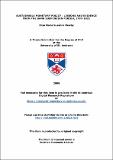Files in this item
Sustainable monetary policy : lessons and evidence from the bank suspension period, 1797-1821
Item metadata
| dc.contributor.advisor | Nolan, Charles | |
| dc.contributor.author | Newby, Elisa Maria Susanna | |
| dc.coverage.spatial | 282 | en |
| dc.date.accessioned | 2008-11-19T15:33:26Z | |
| dc.date.available | 2008-11-19T15:33:26Z | |
| dc.date.issued | 2008-07-25 | |
| dc.identifier | uk.bl.ethos.552147 | |
| dc.identifier.uri | https://hdl.handle.net/10023/555 | |
| dc.description.abstract | This thesis re-examines the suspension of the gold standard rule in Britain between 1797 and 1821 within the framework of the theory of credible and time consistent monetary policy. By combining both historical and theoretical analysis the thesis challenges the prevailing theory in which the gold standard is considered as a contingent rule and the suspension as an exogenously credible regime. Firstly, the thesis analyses what made the suspension credible in the absence of the gold standard rule. It is proposed that the suspension was a credible regime, because the resumption of the gold standard at the old par value in the future was a sustainable plan. It is shown that monetary policy during the bad state -- such as war -- can still be time consistent in the absence of the formal commitment rule, if the policy maker's plan is to resume the original commitment rule when the economy returns to the good state. The equilibrium is based on trigger strategies where private agents retaliate if a policy maker deviates from its policy plan to resume the gold standard rule. Secondly, the thesis aims to establish why the gold standard rule was suspended for twenty-four years. Both historical analysis and a dynamic general equilibrium model demonstrate that the gold standard was a shock amplifier when the shocks became persistent in the 1790s, and suspension was used to restore monetary stability during the French Wars. As the suspension of cash payments was a credible regime, it maintained the value and circulation of paper currency that in turn stabilised production and consumption. Suspension increased the degree of flexibility in the economic policy as the monetary authority had an opportunity to stimulate the economy by issuing fiat money during the war, on the understanding that the fiat money so issued would be withdrawn from circulation before the gold standard resumed. Finally, it is explained why the gold standard was resumed after the relatively successful Suspension Period. The gold standard was seen as a solution to the problem that arose from the Bank of England's ambiguous role as a public and private institution. Rules were considered to be better than discretion, and the gold convertibility was a transparent principle, which maximised the long-run welfare of the society. The thesis demonstrates how already in the eighteenth century commitment to the gold standard rule had increased the efficiency of capital markets and enabled Britain to finance its eighteenth-century wars by using deficit finance. Maintaining these abilities through the gold standard was desirable. | en |
| dc.format.extent | 1188643 bytes | |
| dc.format.mimetype | application/pdf | |
| dc.language.iso | en | en |
| dc.publisher | University of St Andrews | |
| dc.rights | Creative Commons Attribution-NonCommercial-NoDerivs 3.0 Unported | |
| dc.rights.uri | http://creativecommons.org/licenses/by-nc-nd/3.0/ | |
| dc.subject | Monetary policy | en |
| dc.subject | Gold standard | en |
| dc.subject | Suspension period | en |
| dc.subject | Monetary theory | en |
| dc.title | Sustainable monetary policy : lessons and evidence from the bank suspension period, 1797-1821 | en |
| dc.type | Thesis | en |
| dc.type.qualificationlevel | Doctoral | en |
| dc.type.qualificationname | PhD Doctor of Philosophy | en |
| dc.publisher.institution | The University of St Andrews | en |
This item appears in the following Collection(s)
Except where otherwise noted within the work, this item's licence for re-use is described as Creative Commons Attribution-NonCommercial-NoDerivs 3.0 Unported
Items in the St Andrews Research Repository are protected by copyright, with all rights reserved, unless otherwise indicated.


